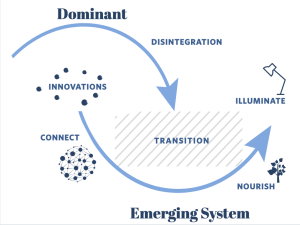Two-Loop Model
Dr. Stefan Grzybowski discusses the Two-Loop Model and how it can be applied to resilience to climate change (2:35)
As vulnerable social-ecological systems, rural and remote communities must prove that they are able to transform in a way that can ensure long-term sustainability, including resilience to future environmental and social disturbances. As such, careful analysis and adaptation of previous and contemporary structures as well as systems must be conducted in order to establish a robust framework for change and transformation, a notion that is particularly relevant in the context of building rural community resilience. However, the methods we choose to help facilitate and bring about change are contingent on the goals of value-driven transformation, such as incorporating sustainable growth. These methods must also demonstrate respect for past systems to ensure a collaborative and informed approach to systems change.
One promising framework that encapsulates these criteria and aims to provoke transformation in a way that aligns with these core values is the Berkana Two-Loop Model which was inspired by the Two Loop Theory of Organizational Change developed by Wheatley and Frieze.13 This approach to change utilizes a non-linear process when analyzing how a system falls and how new systems gain traction, ultimately leading to their position of superiority.13,14 Thus, the Two Loop Model, which is often utilized as a mapping tool for complex systems, demonstrates the deterioration of structures that fail to address current systemic issues.13 It is also important to note here that the rise of a new, dominant system is often in response to some kind of disruption; in other words, there needs to be a notable perturbation that drives change.15 The applicability of this model for transformative resilience in the face of climate change is clear.

Contemporary systems, which are beginning to decline and degenerate, focus on aspects such as economic growth, individualism, and short-term thinking.16 However, the emerging system, which places emphasis on collectivism, sustainable growth, and the alignment of short-term climate-focused actions with long-term climate-resilient goals, is the intersection that we believe will be a key facilitator to transformation as these qualities are components that are essential to the growth and maintenance of a robust system.
“When separate, local efforts connect with each other as networks, then strengthen as communities of practice, suddenly and surprisingly, a new system emerges at a greater level of scale.”
– Deborah Frieze15
Kate Feldman discusses the Two-Loop Model in relation to food production and how these models can help us to be more forward-looking (2:59)

